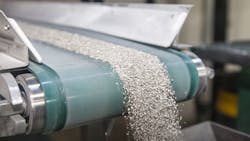Mechanical conveying part 1: Characteristics of mechanical conveyors for powders and bulk solids
There are many methods of moving powders and bulk solid materials. These include moving materials by truck or railcar, pneumatic conveying systems, unit handling of materials in boxes, drums, bags, or other containers, and even moving small amounts of material by hand. While these methods are often the most effective means for moving material and should be considered when choosing the best options for a plant, they are beyond the scope of this article. This article will focus on mechanical conveying and the types of mechanical conveyors commonly found in industrial processing facilities.
The first installment of this two-part article will discuss characteristics that are shared by all mechanical conveying systems. The second installment, which will appear in Processing’s August issue, will describe the most popular mechanical conveyor types used in the processing industries and explain the advantages and disadvantages of each type.
Characteristics shared by most mechanical conveying systems
Every powder and bulk processing application has specific requirements, and each material has unique properties with respect to flowability, abrasiveness, friability, dustiness, and others. As a result, equipment suppliers have developed a wide variety of conveying options to meet processors’ specific needs. While these systems can vary greatly from each other in design and operating mechanism, most generally share the following characteristics.
Simple and reliable. Well-designed mechanical conveyors can remain in use for a long time. The concepts and components are simple, and the systems are very reliable when applied correctly.
Economical. Compared to other conveying methods, mechanical conveying is often less expensive and may have simple, off-the-shelf solutions. Modular, standard designs mean that many components can be mass produced, achieving a good economy of scale for standard equipment.
Customizable. Many equipment suppliers are good at customizing equipment when needed for a specific application. Cost and lead time will go up accordingly, but it is well worth it if standard options do not meet a project’s goals.
Efficient. Mechanical conveying is usually very energy efficient compared to other conveying options, particularly pneumatic conveying. Motor horsepower is smaller for mechanical systems, which reduces the upfront cost of motor control centers as well as the system’s ongoing energy costs. This may not be a big savings for low conveying rates and distances, but it can be a significant factor for plants conveying many tons of material hundreds of feet or more.
Volumetric sizing. Mechanical conveyor sizing is done on a volumetric basis. The material’s volume is then multiplied by its bulk density to determine the mass flow rate. Accordingly, knowing your material’s bulk density is important. A material’s bulk density varies, however, so proper evaluation, consulting, and testing should be done to determine whether the material’s loose, compacted or aerated bulk density value should be used. Using the wrong bulk density value can lead processors to choose the wrong size of equipment.
Layout concerns. Of the six most common types of mechanical conveyors, only one easily handles direction changes. Applications that require the material to be conveyed “up and over” may need two separate devices (one for each direction) for most mechanical conveyor types. In addition, most mechanical conveyor types cannot convey at odd upward angles. Some cannot handle long distances or accommodate multiple inlets or outlets. Make sure that layout parameters are part of the project goals.
Abrasive wear concerns. Wear is a factor for all mechanical conveyors handling abrasive material. It is important to know how long the device will last before it needs to be repaired or replaced. Some conveyors handle abrasive materials better than others, so some types should not be considered for abrasive applications unless the usage is occasional.
Cleanliness concerns. Mechanical conveying systems can be difficult and time-consuming to clean and sanitize. Consider the following questions: Does it matter if a heel of material remains in the bottom of the conveyor? What about hygienic cleaning or cross-contamination due to material changeover requirements? Do you need to protect your product from the environment or other contamination? These concerns can quickly eliminate many of the mechanical conveying options and narrow your choices.
Product damage. As with pneumatic conveying, particle breakage during conveying can be a concern with mechanical conveying. If your application requires gentle handling to avoid to particle breakage, then certain conveyor types will be better than others. Low-speed and gentle-handling options are available that avoid material impact, especially high-speed impact between the material and hard surfaces.
Dust concerns. Dust hazards are a major concern for some materials, and most mechanical conveyors are at least partially open systems, which can allow dust to escape into the workspace. Dusty materials may require more enclosed mechanical conveyor types and/or additional dust collection systems, which can be expensive.
Future needs. Mechanical conveying systems tend to be modular and expandable. However, some options have zero flexibility and must be replaced rather than expanded or altered. If your process needs might change over time, choose a system with some flexibility for alterations or add-ons. A system configured from modular components will be more flexible than a system with large custom fabrications.
Selecting a mechanical conveyor
To know which type of mechanical conveyor is best for your application, examine your application requirements, such as conveying rate and layout as well as your material's properties. Simple, off-the-shelf solutions can often work if proper care is taken to choose the right options and features. Also, many equipment suppliers do a great job of customizing equipment when needed, which means that even more options are available.
Such flexibility means that there can be an overwhelming number of options. It can be difficult to choose the best conveying method unless you understand which factors are most important for meeting the project’s goals. It is critical to carefully analyze your material properties, layout, and application requirement upfront.
Material properties. Material properties make a big difference in proper equipment selection. Special care must be taken when choosing conveying options if any of these material properties are evident:
- Very light (low bulk density)
- Very heavy (high bulk density)
- Poor flow, stickiness, cohesiveness or adhesiveness
- Flooding (when the material flows too easily)
- Dusty
- Hazardous or harmful to humans
- Explosive or corrosive
- Fragile or friable
Layout requirements. Layout requirements also play an essential role in equipment selection. What is the distance to be conveyed? Are direction changes needed? If so, how many? Will there be multiple inlets or outlets?
Application requirements. In addition, consider the process requirements of your application. What is the required conveying rate? Will it be a batch or continuous process? Are shutdowns for maintenance or cleaning acceptable, or must they be avoided?
Include all this critical upfront information in your project goals. In addition, the goals should have buy-in from the other process stakeholders at your site. Share the project goals with your equipment vendors and ensure that meeting these goals is a vital part of your vendor selection process.
In next month’s issue, part 2 of this article will discuss the advantages and disadvantages of the six most common mechanical conveyor types for the processing industries: belt conveyors, screw conveyors, bucket elevators, drag conveyors, tubular drag conveyors and flexible screw conveyors.
Todd Smith has helped lead Kansas State University’s Bulk Solids Innovation Center since 2019. Previously, Todd spent 38 years in the bulk solids industry, first at DuPont, then as engineering manager at MAC Equipment (now Schenck Process), and then as general manager of Coperion K-Tron Salina and vice president of the company’s Global Systems Group. He earned a mechanical engineering degree in 1981 and an MBA in 1998, and he regularly lectures on all aspects of bulk solids handling.
About the Author

Todd Smith
Todd Smith has helped manage Kansas State University's Bulk Solids Technology Center since 2019. KSU-BSTC (https://bulk-solids.k-state.edu) is the only university-centered facility and staff in North America dedicated to helping industry with bulk solid challenges and education. Previously, Todd spent his nearly forty-year career in industry working with bulk solids — first at four DuPont plants, then at Mac Equipment (now Schenck Process) and Coperion K-Tron. Todd is also a member of Processing’s editorial advisory board.
